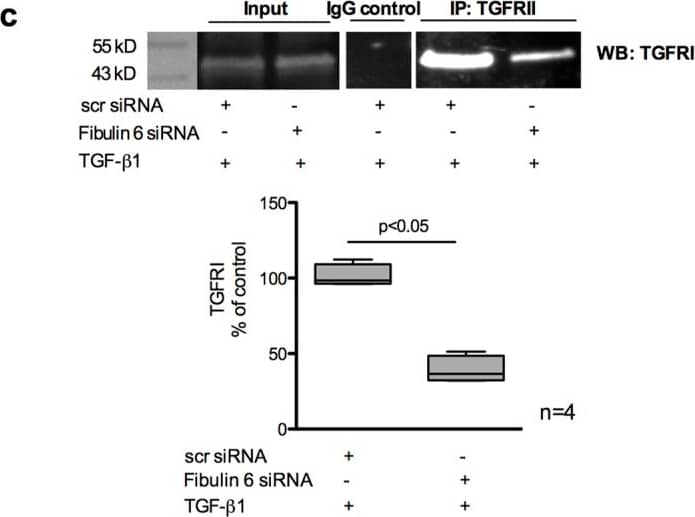TGF-beta RI/ALK-5 Products
Most cell types express three sizes of receptors for TGF-beta. These are designated Type I (53 kDa), Type II (70 - 85 kDa), and Type III (250 - 350 kDa). The Type I receptor is a membrane-bound serine/threonine kinase that apparently requires the presence of the Type II receptor to bind TGF-beta. The Type II receptor is also a membrane-bound serine/threonine kinase that binds TGF-beta1 and TGF-beta 3 with high affinity and TGF-beta 2 with much lower affinity. The Type I and Type II receptors together form a heterodimeric signaling complex that is essential for the transduction of the anti-proliferative signals of TGF-beta. The Type III receptor is a transmembrane proteoglycan with a large extracellular domain and a 43 amino acid residue cytoplasmic domain. The cytoplasmic domain of the Type III receptor lacks an obvious signaling motif and the receptor may not be involved directly in signal transduction.
59 results for "TGF-beta RI/ALK-5" in Products
59 results for "TGF-beta RI/ALK-5" in Products
TGF-beta RI/ALK-5 Products
Most cell types express three sizes of receptors for TGF-beta. These are designated Type I (53 kDa), Type II (70 - 85 kDa), and Type III (250 - 350 kDa). The Type I receptor is a membrane-bound serine/threonine kinase that apparently requires the presence of the Type II receptor to bind TGF-beta. The Type II receptor is also a membrane-bound serine/threonine kinase that binds TGF-beta1 and TGF-beta 3 with high affinity and TGF-beta 2 with much lower affinity. The Type I and Type II receptors together form a heterodimeric signaling complex that is essential for the transduction of the anti-proliferative signals of TGF-beta. The Type III receptor is a transmembrane proteoglycan with a large extracellular domain and a 43 amino acid residue cytoplasmic domain. The cytoplasmic domain of the Type III receptor lacks an obvious signaling motif and the receptor may not be involved directly in signal transduction.
Potent, selective inhibitor of TGF-βRI, ALK4 and ALK7
| Chemical Name: | 4-[4-(1,3-benzodioxol-5-yl)-5-(2-pyridinyl)-1H-imidazol-2-yl]benzamide |
| Purity: | ≥99% (HPLC) |
SB 431542 synthesized to cGMP guidelines
| Chemical Name: | 4-[4-(1,3-benzodioxol-5-yl)-5-(2-pyridinyl)-1H-imidazol-2-yl]benzamide |
| Purity: | ≥99% |
Selective inhibitor of TGF-βRI, ALK4 and ALK7
| Chemical Name: | 3-(6-Methyl-2-pyridinyl)-N-phenyl-4-(4-quinolinyl)-1H-pyrazole-1-carbothioamide |
| Purity: | ≥98% (HPLC) |
| Reactivity: | Human |
| Details: | Goat IgG Polyclonal |
| Applications: | WB, ELISA, ICC |
Potent and selective inhibitor of TGF-βRI
| Alternate Names: | E-616452,SJN 2511,ALK5 Inhibitor II |
| Chemical Name: | 2-(3-(6-Methylpyridine-2-yl)-1H-pyrazol-4-yl)-1,5-naphthyridine |
| Purity: | ≥99% (HPLC) |
| Reactivity: | Human, Mouse |
| Details: | Rat IgG2a Monoclonal Clone #141231 |
| Applications: | WB |
| Reactivity: | Mouse |
| Details: | Goat IgG Polyclonal |
| Applications: | WB |
| Reactivity: | Mouse |
| Details: | Goat IgG Polyclonal |
| Applications: | WB |
| Source: | NS0 |
| Accession #: | P36897 |
| Applications: | BA |
| Reactivity: | Human |
| Details: | Goat IgG Polyclonal |
| Applications: | WB |
This item is in process of being discontinued.
Recombinant Monoclonal Antibody.
| Reactivity: | Human, Mouse |
| Details: | Rat IgG2a Monoclonal Clone #141231R |
| Applications: | WB |
| Reactivity: | Mouse |
| Details: | Rat IgG2a Monoclonal Clone #141229 |
| Applications: | WB |
Biotinylated
| Source: | HEK293 |
| Accession #: | P36897.1 |
| Applications: | BA, BA |
Recombinant Monoclonal Antibody.
| Reactivity: | Human |
| Details: | Mouse IgG1 Monoclonal Clone #854621R |
| Applications: | ELISA |
Selective inhibitor of TGF-βRI, ALK4 and ALK7
| Chemical Name: | 2-[4-(1,3-Benzodioxol-5-yl)-2-(1,1-dimethylethyl)-1H-imidazol-5-yl]-6-methyl-pyridine |
| Purity: | ≥98% (HPLC) |
| Applications: | ELISA |
| Reactivity: | Mouse |
| Details: | Rat IgG2 Monoclonal Clone #RM0016-3A11 |
| Applications: | IHC, WB |
| Applications: | ELISA |
| Applications: | PAGE |
| Applications: | WB |
| Reactivity: | Mouse |
| Details: | Rat IgG2 Monoclonal Clone #RM0016-3A11 |
| Applications: | IHC, WB |
ALK4 and ALK5 (TGFβRI) inhibitor
| Alternate Names: | LY 2157299 |
| Chemical Name: | 4-[5,6-Dihydro-2-(6-methyl-2-pyridinyl)-4H-pyrrolo[1,2-b]pyrazol-3-yl]-6-quinolinecarboxamide |
| Purity: | ≥98% (HPLC) |












![ELISA: Human TGF-beta RI/ALK-5 ELISA Kit (Colorimetric) [NBP3-38694] Human TGF-beta RI/ALK-5 ELISA Kit (Colorimetric)](https://resources.bio-techne.com/images/products/nbp3-38694_human-tgf-beta-ri-alk-5-elisa-kit-colorimetric-2110202415403182.png)
![Immunohistochemistry-Paraffin: TGF-beta RI/ALK-5 Antibody (RM0016-3A11) - Azide and BSA Free [NBP2-11921] Immunohistochemistry-Paraffin: TGF-beta RI/ALK-5 Antibody (RM0016-3A11) - Azide and BSA Free [NBP2-11921]](https://resources.bio-techne.com/images/products/TGF-beta-RI-ALK-5-Antibody-RM0016-3A11-Immunohistochemistry-Paraffin-NBP2-11921-img0002.jpg)
![ELISA: Human TGF-beta RI/ALK-5 - Ready-To-Use ELISA Kit (Colorimetric) [NBP3-38693] Human TGF-beta RI/ALK-5 - Ready-To-Use ELISA Kit (Colorimetric)](https://resources.bio-techne.com/images/products/nbp3-38693_human-tgf-beta-ri-alk-5-ready-to-use-elisa-kit-color-2110202415282629.png)
![SDS-PAGE: Recombinant Human TGF-beta RI/ALK-5 Isoform 1 hIgG-His Protein [NBP2-61985] SDS-PAGE: Recombinant Human TGF-beta RI/ALK-5 Isoform 1 hIgG-His Protein [NBP2-61985]](https://resources.bio-techne.com/images/products/Recombinant-Human-TGF-beta-RI-ALK-5-Isoform-1-Protein-SDS-Page-NBP2-61985-img0001.jpg)
![Western Blot: TGF-beta RI/ALK-5 Overexpression Lysate [NBL1-16856] Western Blot: TGF-beta RI/ALK-5 Overexpression Lysate [NBL1-16856]](https://resources.bio-techne.com/images/products/TGF-beta-Receptor-I-Overexpression-Lysate-Adult-Normal-Western-Blot-NBL1-16856-img0002.jpg)

